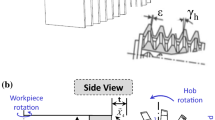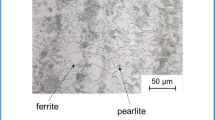Abstract
Gear finish hobbing is a method for soft finishing of external cylindrical power transmission gears. The application of this process is required when the process chain of gear production is to be set up completely free of coolant. Since this finishing technology is relatively new, there is some practical experience, but no fundamental knowledge regarding economical process design. One challenge in process design is that unbalanced tool wear typically leads to geometrical deviations of the machined gear profile. The aim of the investigations described in this paper is to develop a wear model which is capable to predict the local tool wear of gear finish hobbing tools. This model is based on analogy cutting trials and geometrical analyses of the chip geometries in gear finish hobbing. The results of the model are validated by fly-cutting trials with different local loads on the tool. The validation shows that an optimization of the local tool wear development can be achieved by means of the prediction model. Therefore, an optimization of the technological process parameters can be carried out based on this model to reach an efficient process design.







Similar content being viewed by others
References
Brecher C, Weck M, Klocke F, Rütjes U (2005) Analysis of a bevel gear cutting process by manufacturing simulation. Prod Eng 12(2):107–110
Weck M, Klocke F, Winter W, Winkel O (2003) Analysis of gear hobbing processes by manufacturing simulation. Prod Eng 10(1):55–58
Komori M, Sumi M, Kubo A (2003) Simulation of hobbing for analysis of cutting edge failure due to chip Crush. ASME report PTG-48068
Abood AM, Bicker R, Pennell T (2002) An analysis of cutting forces in gear hobbing. VDI Berichte 1665:129–143
Bouzakis K-D, Kombogiannis S, Antoniadis A, Vidakis N (2002) Gear hobbing cutting process simulation and tool wear prediction models. J Manuf Sci Eng 124:42–51
Biermann D, Kahnis P (2010) Analysis and simulation of size effects in micromilling. Prod Eng 4:25–34
Brinksmeier E, Riemer O (2000) Wirkmechanismen bei der Mikrozerspanung. Materialwiss Werkstofftech 31(8):754–759
Wang J, Shi J, Gong Y, Abba G, Cai G (2008) A micro milling model considering metal phases and minimum chip thickness. Key Eng Mater 375–376:505–509
Liu X, DeVor RE, Kapoor SG (2006) An analytic model for the prediction of minimum chip thickness in micromachining. J Manuf Sci Eng 128:474–480
Klocke F, Weber G (2003) Einfluss unterschiedlicher Gefügezustände auf den Werkzeugverschleiß bei der Feinbearbeitung von einsatzgehärtetem Stahl. AiF 12633N/1
Author information
Authors and Affiliations
Corresponding author
Rights and permissions
About this article
Cite this article
Klocke, F., Gorgels, C., Weber, GT. et al. Prognosis of the local tool wear in gear finish hobbing. Prod. Eng. Res. Devel. 5, 651–657 (2011). https://doi.org/10.1007/s11740-011-0343-9
Received:
Accepted:
Published:
Issue Date:
DOI: https://doi.org/10.1007/s11740-011-0343-9




